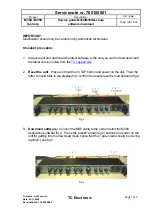
÷(UPICR.C 1)
CLOCK
Pin
uPP
Receive Timing
and Control
Processor
÷2
Transmit
Clock
Module
Clock
Transmit
Clock
÷(UPICR.C 1)
CLOCK
Pin
uPP
Transmit Timing
and Control
Processor
÷2
Module
Clock
Architecture
1538
SPRUH82C – April 2013 – Revised September 2016
Copyright © 2013–2016, Texas Instruments Incorporated
Universal Parallel Port (uPP)
32.2 Architecture
32.2.1 Clock Generation and Control
The uPP peripheral uses two separate clocks: a module clock that controls its internal logic, and a
transmit clock that runs either interface channel in transmit mode. The source for each of these clocks
may be configurable; see the
Device Clocking
chapter for more information. Neither the module clock nor
the transmit clock can be faster than one-half the device CPU clock speed.
Each channel’s CLOCK pin, or I/O clock, is obtained independently based on its operating direction.
32.2.1.1 Transmit Mode (Single Data Rate)
The channel drives a clock signal on its CLOCK pin. The uPP transmit clock is divided by a fixed value of
2, then divided again by a user-specified value between 1 and 16 (UPICR.CLKDIV
n
+ 1). The resulting
signal then drives the CLOCK pin. The following formula determines the final I/O clock speed:
I/O Clock = Transmit Clock/(2 ×
(UPICR.C 1))
The fixed divisor restricts the maximum speed of the I/O clock to one-fourth the device CPU clock speed.
shows the clock generation system for a channel configured in transmit mode.
Figure 32-6. Clock Generation for a Channel Configured in Transmit Mode
32.2.1.2 Receive Mode (Single Data Rate)
The channel requires an external clock to drive its CLOCK pin. The incoming clock is not divided, and its
maximum allowed speed is one fourth (¼) the device CPU clock speed.
shows the clock generation system for a channel configured in receive mode.
Figure 32-7. Clock Generation for a Channel Configured in Receive Mode















































